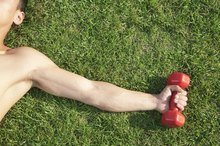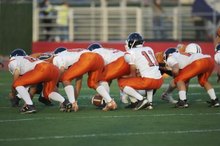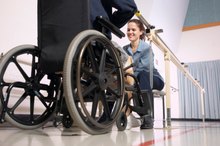Daily Function of Gluteal Muscles
When asking what function your glutes serve on a day-to-day basis, the answers are plentiful. In fact, it might be easier to talk about what the glutes don't do regularly. Each gluteal muscle — that's the maximum, medius and minimus — moves your thigh in different directions. Working together, they affect your ability to stand from a squatted position, climb stairs and walk uphill. They also play an important role in maintaining your balance.
The gluteus maximus muscle lies closest to the surface and attaches your pelvis to the upper thigh bone, moving your leg backward and out to the side, as well as assisting with outward rotation of your thigh. The gluteus medius lies underneath and slightly higher than the maximus, running from the top of your pelvis to the outer edge of your upper thigh bone. This muscle brings your leg out to the side and rotates it inward and outward. The gluteus minimus lies underneath the medius, attaching your pelvis to your upper thigh bone, and mainly works with the medius to move your leg out to the side and to rotate your thigh inward.
Read More: Workouts to Develop Glute Muscles
Gluteus Maximus
The gluteus maximus muscle helps maintain your balance as you walk or run. As your leg comes forward and your heel hits the ground, this muscle tightens to slow down the forward movement of your leg and keep you balanced. When you run, this muscle tightens on the leg you are standing on to control the forward momentum of your trunk.
Although the quadriceps muscles on the front of your thighs primarily move your legs forward as you walk or run, the gluteus maximus muscle tightens to help propel your body forward on hills or uneven surfaces. This muscle also lifts you from a squatted position and helps you climb stairs.
- The gluteus maximus muscle helps maintain your balance as you walk or run.
- As your leg comes forward and your heel hits the ground, this muscle tightens to slow down the forward movement of your leg and keep you balanced.
Gluteus Medius
Muscles Used in Hip Extension
Learn More
As you lift your leg to take a step, the medius tightens on the stationary side to prevent your pelvis from dropping down when you pick your foot up. Weakness in this muscle causes an abnormal walking pattern called the Trendelenburg gait. When this occurs, the upper body leans over the leg you are standing on to shift your center of gravity over that leg to keep you balanced. Gluteus medius weakness also shortens the length of your steps, making your walking strides less efficient.
Read More: The Advantages of Strong Glutes
- As you lift your leg to take a step, the medius tightens on the stationary side to prevent your pelvis from dropping down when you pick your foot up.
Gluteus Minimus
As its name implies, the gluteus minimus is the smallest of your gluteal muscles. Depending on which part of the muscle is active, it can move your thigh forward, move it out to the side or rotate it inward or outward. Your hip is a ball-and-socket joint formed by your pelvis and thigh bone, and the gluteus minimus helps keep the ball in the socket as you move.
Related Articles
References
- Physiopedia: Gluteus Maximus
- Physiopedia: Gluteus Medius
- Yoga Anatomy: Gluteus Minimus
- ScienceDirect. Gluteus minimus muscle.
- Reid D. The management of greater trochanteric pain syndrome: A systematic literature review. J Orthop. 2016;13(1):15-28. doi:10.1016/j.jor.2015.12.006
- SportsRec. Physical therapy exercises for the gluteus minimus.
- Labrosse JM, Cardinal E, Leduc BE, et al. Effectiveness of ultrasound-guided corticosteroid injection for the treatment of gluteus medius tendinopathy. AJR Am J Roentgenol. 2010;194(1):202-6. doi:10.2214/AJR.08.1215
- Whiler L, Fong M, Kim S, et al. Gluteus medius and minimus muscle structure, strength, and function in healthy adults: Brief report. Physiother Can. 2017;69(3):212-216. doi:10.3138/ptc.2016-16
Writer Bio
Aubrey Bailey has been writing health-related articles since 2009. Her articles have appeared in ADVANCE for Physical Therapy & Rehab Medicine. She holds a Bachelor of Science in physical therapy and Bachelor of Arts in psychology from the University at Buffalo, as well as a post-professional Doctor of Physical Therapy from Utica College. Dr. Bailey is also a certified hand therapist.






